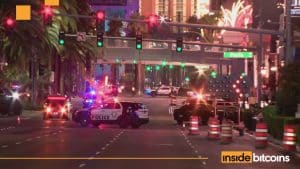Recent events on the Las Vegas Strip highlight the complex challenges facing America’s entertainment capital, where violent incidents intersect with evolving tourism patterns and employment dynamics. A deadly shooting near the iconic Bellagio fountains has once again brought safety concerns to the forefront, while the city’s hospitality industry grapples with significant workforce changes amid shifting visitor preferences and economic pressures.
Recent Violence Rocks Tourist Hub
The Las Vegas Strip experienced another tragic incident when gunfire erupted near the famous Bellagio fountains, resulting in two fatalities and sending shockwaves through one of the world’s busiest tourist destinations. Law enforcement officials responding to the scene discovered that this wasn’t a random act of violence, but rather the culmination of ongoing disputes that had played out across social media platforms.
Officers conducting routine patrols heard the gunshots and immediately rushed toward the disturbance, where they found two individuals suffering from apparent gunshot wounds. Despite rapid response from emergency medical personnel, both victims were pronounced dead at the scene. The incident forced temporary closure of several blocks along the Strip while investigators processed evidence and searched for the perpetrator.
The suspect, later identified as 41-year-old Manuel Ruiz, eventually surrendered to authorities at the Henderson Police Station. Police characterized the shooting as an isolated incident, emphasizing that the individuals involved knew each other and had a documented history of conflict stemming from social media interactions. This pattern of online disputes escalating to real-world violence reflects broader trends in how personal conflicts manifest in the digital age.
The shooting location holds particular significance as the Bellagio fountains represent one of Las Vegas’s most recognizable attractions, drawing millions of visitors annually with water displays choreographed to music. The fountains operate on a precise schedule, presenting shows every 30 minutes during afternoon hours and increasing frequency to every 15 minutes during peak evening periods. The temporary suspension of fountain operations following the shooting underscored the incident’s impact on normal tourist activities.
Tourism Industry Dynamics and Visitor Patterns
Las Vegas continues to demonstrate remarkable resilience in attracting visitors, with the city welcoming approximately 41.7 million tourists in 2024. This figure represents a steady recovery from pandemic-related disruptions and approaches the pre-2020 levels that established Las Vegas as one of America’s premier destinations. The tourism industry’s performance has exceeded expectations, with 54 percent of visitors reporting that Las Vegas surpassed their anticipated experience, compared to 48 percent in 2022.
The visitor demographic profile reveals interesting shifts in who chooses Las Vegas as their destination. A record-breaking 86 percent of 2024 visitors were repeat guests, indicating strong loyalty and satisfaction with the Las Vegas experience. The typical visitor profile has evolved to include more college-educated individuals earning over $100,000 annually, while the proportion of visitors in their twenties has decreased as millennials and Generation X travelers comprise larger shares of the tourist base.
International visitation has stabilized at approximately 12 percent of total visitors, representing a gradual recovery from pandemic lows. This international component remains crucial for the city’s economic diversity, though domestic tourism continues to drive the majority of visitation. Monthly visitor volumes averaged over 3 million people throughout 2024, with March recording the highest numbers at 3.67 million visitors.
Convention attendance adds another significant layer to Las Vegas tourism, with over 5.71 million convention attendees recorded through November 2024. These business travelers often extend their stays for leisure purposes, creating additional economic impact beyond the primary conference or trade show activities. The convention segment has shown strong recovery, with monthly attendance ranging from approximately 250,000 to over 760,000 depending on scheduled events.
Economic Impact and Industry Contributions
Nevada’s tourism industry generated nearly $98 billion in total economic impact during 2024, representing 37 percent of the state’s gross domestic product. This massive economic footprint supports 436,600 jobs across the state, accounting for 28 percent of total employment. The industry’s wage and salary payments reached $24.4 billion, while industry-specific taxes and fees contributed $2.4 billion to state coffers.
Gaming revenue alone generated $15.8 billion in fiscal year 2024, demonstrating the continued importance of casino operations to Nevada’s economy. The tourism sector provides 34 percent of the state’s general fund revenue, making it essential for funding public services including education and infrastructure. Current and planned major tourism-related capital investment projects total $18 billion, indicating continued confidence in the sector’s long-term prospects.
The employment landscape within tourism and hospitality reveals both opportunities and challenges. Nevada casino dealers earned an average hourly wage of $19.96 in 2024, comparable to the national average of $19.25. However, despite Nevada’s prominence in the casino industry, the state did not rank among the top five highest-paying states for casino dealers, suggesting competitive pressures and cost management considerations.
Employment Challenges in Hospitality Sector
The Las Vegas metropolitan area concluded 2024 with an unemployment rate of 5.9 percent, marking the highest among major U.S. metropolitan areas. This elevated unemployment rate reflects significant challenges within the leisure and hospitality industry, where traditional employment patterns are experiencing disruption from technological advancement and changing operational strategies.
Automation has emerged as a primary factor affecting casino dealer employment, with many venues implementing electronic table games that require fewer human operators. This technological shift represents a fundamental change in how casinos operate, prioritizing efficiency and cost reduction over traditional service models. Large establishments have responded to declining earnings by reducing workforce levels, with facilities like Fontainebleau implementing substantial dealer layoffs as industry growth has decelerated.
Hotel occupancy rates have experienced declines, falling 1 percent overall in April 2024, with downtown properties showing a more pronounced 2.6 percent decrease. These occupancy challenges directly impact employment levels across the hospitality sector, as reduced guest volumes necessitate smaller staffing levels for housekeeping, food service, and guest services positions.
Dealer training schools have noted decreased enrollment and reduced interest in casino careers, contrasting with historical patterns where individuals relocated to Las Vegas specifically for gaming industry opportunities. This trend suggests both reduced confidence in job security within the sector and potentially changing career preferences among younger workers. The appearance of online crypto casinos are often cited as factors contributing to these trends.
Historical Context of Violence in Las Vegas
The recent Bellagio shooting occurs against the backdrop of Las Vegas’s most traumatic violent incident, the October 1, 2017 mass shooting at the Route 91 Harvest music festival. That attack, perpetrated by 64-year-old Stephen Paddock from his 32nd-floor Mandalay Bay suite, resulted in 60 deaths and over 413 wounded, with panic bringing total injuries to approximately 867 people.
The 2017 incident remains the deadliest mass shooting by a lone gunman in American history, fundamentally changing security protocols and safety perceptions for large-scale events in Las Vegas. Paddock fired more than 1,000 rounds at concert-goers before taking his own life, using bump stocks to achieve rapid-fire capabilities similar to automatic weapons. The motive for that attack was never definitively established, leaving investigators and the public without closure regarding the perpetrator’s intentions.
Following the 2017 shooting, Las Vegas implemented enhanced security measures across major venues and events. The incident prompted national discussions about firearm regulations, particularly regarding bump stocks, which were subsequently banned by the U.S. Justice Department in December 2018, though this ban was later overturned by the Supreme Court in 2024 for lacking legislative basis.
The contrast between the 2017 mass shooting and the recent Bellagio incident illustrates different types of violence that can impact tourist destinations. While the 2017 attack appeared to be indiscriminate violence against strangers, the recent shooting involved individuals with prior conflicts, representing more targeted violence that escalated from personal disputes.
Visitor Experience and Safety Perceptions
Despite these incidents, visitor satisfaction rates have actually increased, with Las Vegas consistently exceeding guest expectations across multiple metrics. The city’s ability to maintain high satisfaction levels while addressing security concerns demonstrates the effectiveness of enhanced safety protocols and the resilience of Las Vegas’s entertainment offerings.
Tourism officials have expressed cautious optimism about maintaining visitor confidence while acknowledging that affordability concerns pose ongoing challenges. Eighteen percent of guests cited financial concerns as their primary worry, with rising costs potentially deterring future visits. This economic pressure intersects with safety concerns to create complex decision-making factors for potential visitors.
The Strip’s reputation as a safe environment for tourists has been carefully cultivated through visible security presence, advanced surveillance systems, and rapid emergency response capabilities. The quick police response to the Bellagio shooting exemplifies these preparedness measures, though such incidents inevitably raise questions about comprehensive safety in high-density tourist areas.
Industry Adaptation and Future Outlook
Las Vegas venues are actively adapting to changing visitor preferences by emphasizing experiential amenities over traditional gaming offerings. This strategic shift recognizes that modern tourists seek diverse entertainment options beyond slot machines and table games. Upcoming attractions, including Universal Studios’ horror-themed experience and the Oakland Athletics’ $1.75 billion stadium project, represent significant investments in non-gaming entertainment.
The transformation reflects broader trends in leisure travel, where visitors prioritize unique experiences and memorable activities. Resorts are investing in shows, dining experiences, retail offerings, and recreational activities that appeal to diverse demographic groups and create multiple revenue streams beyond gaming operations.
Economic uncertainty continues to influence consumer behavior, though rising consumer confidence suggests potential improvements in visitor spending patterns. International tourism recovery remains gradual but steady, with expectations that travel restrictions and concerns will continue to ease over time.
Industry experts maintain measured optimism about Las Vegas’s long-term prospects, noting that while growth has been slower than hoped, fundamental economic indicators remain relatively strong. Gaming revenue, while leveled off from immediate post-pandemic highs, continues to generate substantial returns, and major capital investments demonstrate continued corporate confidence in the market.
Related Pages
- The Changing Winds in Sin City: How Declining Smoking Rates Are Reshaping Vegas Casino Culture
- The Shift Towards Smoke-Free Casinos: Public Health and Responsible Gambling
- Texas Gaming Landscape Shifts as Las Vegas Sands Abandons Casino Element in Irving Development
- Best Telegram Casinos & Gambling Bots


